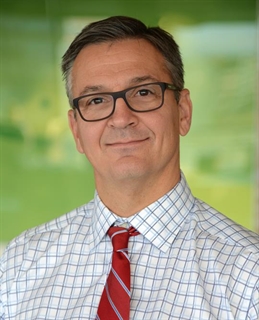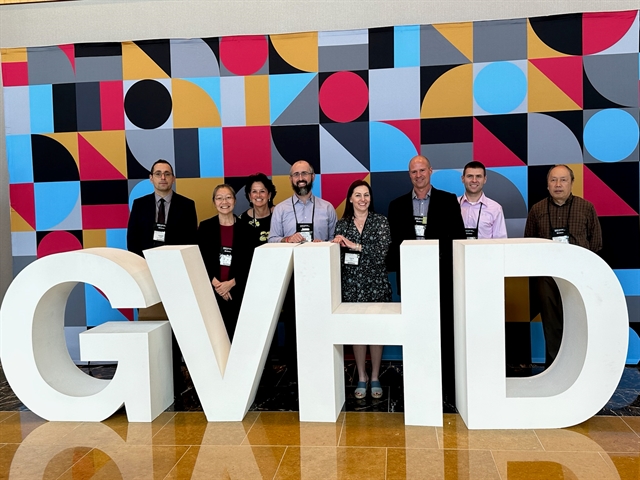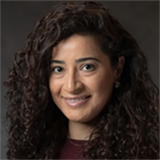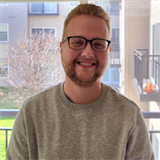Perspectives:
Eisenhower's Roadmap: Paving the Future for Clinician-Scientists
By Michael Verneris, MD

En route from Denver, CO, to Charleston, SC, for Christmas, my wife, two dogs, and I drove past Abilene, KS, where a roadside billboard proudly proclaimed it the birthplace of Dwight Eisenhower, the 34th president of the United States. This revelation sparked a conversation about Eisenhower's pivotal role in establishing the US Interstate Highway System, the very network that we were using for our cross-country travel. The US military website provided insights into Eisenhower's motivations for the creation of the Interstate Highway System, which were shaped by wartime experiences like his participation in the First Transcontinental Motor Convoy and the challenges of cross-country travel. Exposure to the efficient German autobahn during World War II and the Soviet Union's hydrogen bomb detonation in 1953 fueled Eisenhower's fear that inadequate roads could impede Americans from escaping a nuclear disaster. The creation of the Interstate Highway System stands as a testament to Eisenhower’s long-term investment, selfless contributions to the greater good, and the societal and economic impacts such efforts produce.
Similar to Eisenhower's visionary approach, translational clinical research demands foresight, risk-taking, dedication, and investment, akin to a transformative highway project. A recent Nature editorial by Stephen O'Rahilly, MD, highlighted a decline from 4.5% to 1.5% of physician-scientists over the past two decades, underscoring the challenges faced by many in our field (1). Dr. O'Rahilly, comparing these physician-scientists to a species nearing extinction, emphasized our unique ability to make critical observations based on clinical insights and to bring these back to patients. He also described the benefits of physician-scientists being "bilingual" in both clinical care and research techniques, skills that take years to develop. Although in sections of Dr. O'Rahilly's piece, it was implied that physician-scientists perform laboratory research, he remained silent on the exact definition, leaving room for the inclusion of other non-wet lab researchers, including clinical trialists and population scientists, a perspective I endorse.
Dr. O'Rahilly’s piece briefly outlines the time and effort required to find, train, and cultivate such individuals early in their careers, shedding light on the challenges of postgraduate training and funding. The allure of the pharmaceutical industry often diverts talented individuals away from becoming clinician-scientists, and Dr. O'Rahilly offers advice for cultivating these rare individuals. While he describes the physician-scientist as an endangered species, he refrains from drawing parallels with invasive species and loss of habitat, possibly a lost opportunity.
In part, Dr. O’Rahilly’s piece seems to have been spurred by a recent publication by Kelly M. Gillen, PhD, MBA, and colleagues, who used NIH RePORTER historical data files for fiscal years 2011 to 2021 to investigate funding gaps (2). Their research showed that nearly three-quarters of individuals with a prior RO1 needed gap funding for at least two years before obtaining another one RO1. While this need for gap funding is not evenly distributed, with those with higher funding requiring less support, the authors conclude that gap funding is becoming more the norm than the exception. In the introduction to Dr. Gillen’s paper, Jennifer M. Kwan, MD, PhD, cites staggering statistics, noting that, over the past 25 years, unsuccessful NIH RO1 grant proposals have increased from 14,000 to more than 29,000 per year, creating significant barriers to obtaining critical research funding (3).
To address these challenges, something akin to an Eisenhower-like movement in the realm of clinical research is imperative. Perhaps funding mechanisms should be restructured to support the dual roles of clinician and scientist, recognizing the unique pressures and contributions that we make to both patient care and scientific advancement. Academic institutions should seriously consider the implications of the aforementioned statistics and incorporate these data into their budgetary considerations, while hospital administrators need to acknowledge the reputational value of having such individuals on staff. This theory of investment aligns with Eisenhower’s understanding that infrastructure is crucial for societal well-being. Here, academic medical centers are the institutions best positioned to carry out this mission for the advancement of clinical science.
In conclusion, Eisenhower’s legacy of the US Interstate Highway System provides an aspirational template for addressing challenges faced by clinician-scientists. By restructuring funding mechanisms, protecting clinical loads, and actively investing in training the next generation, we should build a robust infrastructure that not only fosters the swift translation of discoveries but also ensures a lasting impact—much like the creation of the Interstate Highway System, which proved crucial to our nation’s progress.
References
- O'Rahilly S. Academic clinician-scientists risk becoming an endangered species. Nature Medicine. 2023 Dec 1; 29(12):2989. doi: 10.1038/s41591-023-02626-8. PMID: 38087113.
- Gillen KM, Markowitz DM, Long P, Villegas-Estrada A, Chang E, Gupta A. National Institutes of Health funding gaps for principal investigators. JAMA Network Open. 2023 Sep 5; 6(9):e2331905. doi: 10.1001/jamanetworkopen.2023.31905. PMC10509726.
- Kwan JM, Gross CP. Improving support for physician scientists - Mind the (funding) gap. JAMA Network Open. 2023 Sep 5; 6(9):e2332982. doi: 10.1001/jamanetworkopen.2023.32982. PMID: 37725379.
Graft-Versus-Host Disease Working Committee

Pictured left to right: Joseph Pidala (former Working Committee Co-Chair), Stephanie Lee, Margaret MacMillan, Zachariah DeFilipp, Carrie Kitko, Stephen Spellman, Michael Heim, and Tao Wang.
 |
 |
| Najla El Jurdi |
Jakob Devos |
Committee Leadership
Co-Chairs:
- Carrie Kitko, Vanderbilt University Medical Center, Nashville, TN
- Margaret MacMillan, University of Minnesota Blood and Marrow Transplant Program - Pediatrics, Minneapolis, MN
- Zachariah DeFilipp, Massachusetts General Hospital, Boston, MA
WCTL Chair:
- Najla El Jurdi, University of Minnesota, Minneapolis, MN
Scientific Directors:
- Stephanie Lee, Fred Hutchinson Cancer Center, Seattle, WA
- Stephen Spellman, CIBMTR NMDP, Minneapolis, MN
Statistical Director:
- Tao Wang, CIBMTR MCW, Milwaukee, WI
Statistician:
- Jakob Devos, CIBMTR MCW, Milwaukee, WI
GVHD remains a major complication of allogeneic HCT. Ongoing efforts to understand, prevent, and treat both acute and chronic GVHD are of major importance to the transplant community. The GVHD Working Committee is committed to leveraging CIBMTR’s robust data resources and statistical expertise to address impactful research questions in the field.
The committee is pleased to announce Nosha Farhadfar, MD, as incoming Co-Chair of the GVHD Working Committee and sincerely thanks Margaret MacMillan, MD, MSc, for all of her previous contributions in this role.
The GVHD Working Committee remains very active, with several recent presentations and publications arising from the committee’s study portfolio. Some recent notable examples include studies examining the association between chronic GVHD severity and the development of subsequent neoplasms and non-malignant late effects; donor-engrafted clonal hematopoiesis impact on clinical outcomes in older related donors; the risk for bloodstream infections after acute GVHD; and the impact of racial, ethnic, and socioeconomic health disparities on the outcome of chronic GVHD. Of these studies, one was recently presented at ASH in December 2023, and another is being prepared as an oral presentation for the 2024 Tandem Meetings of ASTCT & CIBMTR later this month.
The committee has seven ongoing studies that will explore new and exciting research avenues. Two studies are in the manuscript preparation phase: One evaluates the performance of a novel risk score based on a highly multiplexed proteomics assay to predict the incidence and severity of acute and chronic GVHD in recipients of HLA-DP mismatched or 7/8 mismatched allogeneic HCT. The second study evaluates the impact of transplant-related factors on GVHD incidence and severity particularly in children and young adults. Additional ongoing studies examine the impact of post-transplant cyclophosphamide compared to calcineurin inhibitor-based GVHD prophylaxis on outcomes in HLA-matched transplants, and the incidence of chronic GVHD in cryopreserved versus fresh peripheral blood allogeneic hematopoietic stem cell grafts. Other studies will implement new analysis approaches and large datasets, including machine learning in one study and multi-state modeling in another. These new approaches for analysis demonstrate the collaborative and adaptive nature of the GVHD Working Committee as the committee seeks to address complex research questions by incorporating novel informatics and analytic approaches. The current study portfolio has great potential to address high-priority research questions in the field. Importantly, this progress could inform optimal donor, graft, and GVHD prophylaxis selection, providing valuable clinical tools to improve patient outcomes.
The GVHD Working Committee is very interested in receiving new proposals and welcomes involvement from junior investigators. Committee leadership recently reviewed new proposals and selected five proposals to be presented during the committee's meeting at the 2024 Tandem Meetings, and other proposal submissions are welcome throughout the year. We are very open to discussing new concepts and are open to consultation and collaboration on proposal development. We also note that datasets from previously published studies are now publicly available for secondary analyses on CIBMTR’s website. More information about this committee is also available online.
Pediatric Cancer Working Committee
Committee Leadership
Co-Chairs:
- Akshay Sharma, St. Jude Children's Research Hospital, Memphis, TN
- Kirk Schultz, British Columbia's Children's Hospital, UBC, Vancouver, BC
- Muna Qayed, Children's Healthcare of Atlanta at Egleston, Atlanta, GA
- Parinda Mehta, Cincinnati Children's Hospital Medical Center, Cincinnati, OH
Scientific Director:
- Larisa Broglie, CIBMTR MCW, Milwaukee, WI
Statistical Director:
- Kwang Woo Ahn, CIBMTR MCW, Milwaukee, WI
Statistician:
- Rasha Atshan, CIBMTR MCW, Milwaukee, WI
The Pediatric Cancer Working Committee provides scientific oversight for studies related to allogeneic and autologous HCT for children, adolescents, and young adults with cancer. As transplantation approaches differ from adults, independent evaluation of pediatric patients is necessary to help advance transplant outcomes for this population.
This past year has seen changes within the Pediatric Cancer Working Committee. We said goodbye to our outgoing Co-Chair, Greg Yanik, MD, and welcomed our incoming Co-Chair, Akshay Sharma, MBBS. Additionally, with the restructuring of CIBMTR’s Graft Sources and Cellular Therapy Working Committees, we also welcomed Parinda Mehta, MD, and Christine Phillips, MD, as Co-Chairs of the Pediatric Cancer Working Committee. These changes will bring in additional expertise and wonderful perspectives that will surely help guide our ongoing and upcoming studies!
We have also been busy working on multiple studies over the past year. A protocol led by Andrea Bauchat, DO, and Muna Qayed, MD, MsCR, evaluating the impact of GVHD on pediatric Disease Risk Index groups is nearing protocol completion and will be circulated to the committee soon. So will a study led by Anand Srinivasan, MD, and Joerg Krueger, MD, comparing bone marrow and peripheral blood grafts in patients receiving haploidentical donor transplants with post-transplant cyclophosphamide. Keep an eye out for these protocols in your inboxes soon – we welcome feedback from the Writing Committee to help make these studies as impactful as possible! Susan Prockop, MD, and her fellow, Alexander Lake, MD, have taken on the daunting task of cleaning chimerism data, to evaluate the effect of T-cell chimerism on relapse in patients with AML and ALL.
Additionally, efforts to improve collaboration with our European colleagues from EBMT and with other collaborative groups are underway. We have been working closely with the Pediatric Disease Working Party of EBMT and are developing a study of haploidentical transplants, comparing alpha-beta T-cell depletion strategies with post-transplant cyclophosphamide. The study, led by Amanda Li, MD, MSc, and Hemalatha Rangarajan, MD, is ongoing, but the discussions and collaboration have been going well so far! We are working on establishing our data use agreement with the Children’s Oncology Group (COG) to merge data on patients with relapsed or refractory Hodgkin lymphoma as well. Both partnerships will hopefully set the stage for future collaborative efforts as well.
There are a few studies that were recently completed or are close to completion. Tristan Knight, MD’s, study evaluating CD34+ cell dose in autologous transplantation for neuroblastoma and central nervous system tumors was published in Bone Marrow Transplantation and Transplantation and Cellular Therapy, respectively. We are finalizing the analysis of “The Impact of Pre-transplant Extramedullary Disease on the Outcome of Allogeneic Hematopoietic Cell Transplantation for Acute Myeloid Leukemia in Children,” led by Deepak Chellapandian, MD, MBBS, and Hemalatha Rangarajan, MD; we hope to share these results soon.
The success of our committee depends on new ideas, testable hypotheses, and participation by individuals with different perspectives and scientific backgrounds. Having an engaged group of investigators allows us to conduct impactful studies. The Pediatric Cancer Working Committee encourages all investigators with an interest in pediatric cancer to propose studies, which may be submitted on CIBMTR’s Propose a Working Committee Study webpage. Additionally, datasets of prior studies are publicly available for download and analysis by independent researchers on the Publicly Available Datasets webpage on CIBMTR’s website. We encourage colleagues with an interest in research with CIBMTR and the Pediatric Cancer Working Committee to reach out to this committee’s leadership to discuss ideas and collaboration. Working Committee Co-Chairs are also always available to discuss your study’s hypothesis and feasibility before submission to CIBMTR. More information about this committee is available online.
2024 Tandem Meetings

By Alicia Halfmann and Maira Brey
We look forward to seeing you later this month at the 2024 Tandem Meetings | Transplantation & Cellular Therapy Meetings of ASTCT and CIBMTR in San Antonio, TX!
If you have not yet registered, there is still time! The 2024 Tandem Meetings will feature in-person and virtual programming, so everyone can experience the premier event in the evolving HCT and cellular therapy field.
Registration: Navigate to the 2024 Tandem Meetings website to register and view additional details.
Mobile App: Download the official Tandem Meetings mobile app for quick and easy access to the most current version of the schedule, venue maps, and more! The app is free for all attendees, and with Wi-Fi available throughout all Tandem Meetings rooms, users can:
- View the times and locations of sessions and networking events
- Build your agenda **If you created a personalized schedule within the online agenda, it will automatically transfer to the mobile app upon login
- Create your attendee profile
- Send messages and meeting requests to other attendees
- Explore interactive maps of the Henry B. González Convention Center
- Compete in the Scavenger Hunt Game
- Participate in live polling during sessions and much more!
Awards & Lectures: Please join us each morning for the Daily Welcome & Awards sessions beginning at 8:15 AM CT. Additionally, the Honorific Lectures (including the Mortimer M. Bortin and E. Donnall Thomas Lectures), the CIBMTR Distinguished Service Award, and the ASTCT Lifetime Achievement Award will be presented Friday afternoon beginning at 5:00 PM CT.
Networking Opportunities: Several networking opportunities will be offered during the Tandem Meetings, including the Tandem Meetings Welcome Reception on Wednesday evening in the Exhibit Hall, the Poster Reception: Meet the Authors on Thursday evening, the Tandem Meetings Closing Reception on Saturday evening, and more.
Evaluations & Credits: As sessions conclude, be sure to complete not only the Session Evaluations but also the Overall Meetings Evaluation. Please note that both evaluation types must be completed to receive access to your CME Credit Certificate. For more information about additional credit types and evaluations, please access the Evaluations and Credits page on the online program and / or mobile app.
Join the Conversation: #Tandem24
Working Committee Training and Leadership Program: Meet 3 More Participants
The Working Committee Training and Leadership Program was first announced during the 2023 Tandem Meetings, and applications were accepted through mid-April 2023. We had an overwhelming response, receiving applications from 77 Early Career Investigators representing more than 65 distinct transplant and cellular therapy centers in 10 countries. The eight participants selected all share a high level of dedication, achievement, and enthusiasm for clinical research. We would like to warmly welcome them to the program and are excited to be a part of their career development. Join us as we continue to highlight the participants in this edition of the newsletter and future editions.
Mariam Nawas, MD: Acute Leukemia Working Committee
I am an assistant professor at the University of Chicago. I am focused on allogeneic HCT and the care of patients with acute leukemias and myeloid malignancies. My research is focused on understanding and reducing transplant and cellular therapy-related toxicities and symptom burden, particularly in older adults. I direct the Transplant Optimization Program at the University of Chicago, a geriatric-assessment-guided multidisciplinary clinic dedicated to the evaluation and optimization of older adults undergoing transplantation and cellular therapy. I aspire to become highly involved in collaborations like CIBMTR and have already benefited immensely from formal training in CIBMTR’s processes and application and participation in the weekly statistical meetings. I am also eager to expand my mentorship team by learning from and working alongside experts in the field.
“Dr. Nawas has already become an integral part of the Acute Leukemia Working Committee. Her contributions to discussions, protocol and analysis reviews, and committee work have been astute and meaningful, and they highlight the bright future she has ahead. We are thrilled to be working with her.” ~ Kristin Page, MD, MHS, MEd, Scientific Director of the Acute Leukemia Working Committee
Jennifer Saultz, DO: Immunobiology Working Committee
I am an assistant professor of medicine and a physician-scientist in the Blood and Marrow Transplant and Cellular Immunotherapy Program at Oregon Health & Science University. My research interests include novel strategies to augment graft versus leukemia through enhancing NK cell recognition of AML before and after allogeneic transplant. I am fortunate to have the opportunity to work with leaders in the field through CIBMTR’s Working Committee Training and Leadership Program. I look forward to opportunities to grow and learn new tools to enhance patient outcomes through research and collaboration. I am excited to join the Immunobiology Working Committee and contribute on a larger scale to the development, implementation, and interpretation of CIBMTR proposals.
“Dr. Saultz has been diving into our committee leadership meetings, and we appreciate that she carefully reviews materials and looks for ways to add value. We look forward to her continued participation and contributions!” ~ Yung-Tsi Bolon, PhD, Scientific Director of the Immunobiology Working Committee
Zeinab El Boghdadly, MD: Infection and Immune Reconstitution Working Committee
I am an associate professor in the Division of Infectious Diseases at the Ohio State University. My clinical and scholarly activities are focused on studying epidemiological, diagnostic, and therapeutic approaches to tackle infections in patients with hematologic malignancies and transplant / cellular therapy recipients. I feel fortunate to be part of CIBMTR’s Working Committee Training and Leadership Program, which has allowed me to interact closely with junior and senior colleagues. The program has provided me with great insight into the infrastructure of the organization, learning about the process of registry data collection, research methodologies, and other operational activities. I would also like to highlight the efforts made by Drs. Page and Broglie to make this a great engaging experience. Being an infectious disease consultant, I believe this program will equip me to contribute effectively to team science efforts with hematology / transplant colleagues and better serve and advance care for our patients.
“Dr. El Boghdadly is an excellent addition to the Infection and Immune Reconstitution Working Committee. She is eager and is actively contributing to ongoing analyses and our Tandem Meetings preparation. She is rapidly becoming familiar with the infection and immune reconstitution data on CIBMTR’s forms. We look forward to her continued participation as she continues in the Working Committee Training and Leadership program.” ~ Marcie Riches, MD, MS, Scientific Director of the Infection and Immune Reconstitution Working Committee
Our Supporters
CIBMTR is supported primarily by Public Health Service U24CA076518 from the National Cancer Institute (NCI), the National Heart, Lung and Blood Institute (NHLBI), and the National Institute of Allergy and Infectious Diseases (NIAID); U24HL138660 from NHLBI and NCI; 75R60222C00008, 75R60222C00009, and 75R60222C00011 from the Health Resources and Services Administration (HRSA); and N00014-23-1-2057 and N00014-24-1-2057 from the Office of Naval Research.
Additional federal support is provided by OT3HL147741, P01CA111412, R01CA100019, R01CA218285, R01CA231141, R01CA231838, R01CA262899, R01AI128775, R01AI150999, R01AI158861, R01HL155741, R21AG077024, U01AI069197, U01AI126612, U24HL157560, and UG1HL069254.
Support is also provided by Boston Children’s Hospital; Fred Hutchinson Cancer Center; Gateway for Cancer Research, Inc.; Jeff Gordon Children’s Foundation; Medical College of Wisconsin; NMDP; NYU Grossman School of Medicine; PBMTF; Rush University Medical Center; St. Baldricks’s Foundation; Stanford University; University of Pittsburgh; and from the following commercial entities: AbbVie; Actinium Pharmaceuticals, Inc.; Adaptive Biotechnologies Corporation; ADC Therapeutics; Adienne SA; Alexion; Allogene; AlloVir, Inc.; Amgen, Inc.; Astellas Pharma US; AstraZeneca; Atara Biotherapeutics; BeiGene; BioLineRX; Blue Spark Technologies; bluebird bio, inc.; Blueprint Medicines; Bristol Myers Squibb Co.; CareDx Inc.; CSL Behring; CytoSen Therapeutics, Inc.; DKMS; Eurofins Viracor, DBA Eurofins Transplant Diagnostics; Gamida-Cell, Ltd.; Gift of Life Biologics; Gift of Life Marrow Registry; GlaxoSmithKline; HistoGenetics; Incyte Corporation; Iovance; Janssen Research & Development, LLC; Janssen/Johnson & Johnson; Jasper Therapeutics; Jazz Pharmaceuticals, Inc.; Karius; Kashi Clinical Laboratories; Kiadis Pharma; Kite, a Gilead Company; Kyowa Kirin; Labcorp; Legend Biotech; Mallinckrodt Pharmaceuticals; Med Learning Group; Merck & Co.; Mesoblast; Millennium, the Takeda Oncology Co.; Miller Pharmacal Group, Inc.; Miltenyi Biotec, Inc.; MorphoSys; MSA-EDITLife; Neovii Pharmaceuticals AG; Novartis Pharmaceuticals Corporation; Omeros Corporation; OptumHealth; Orca Biosystems, Inc.; OriGen BioMedical; Ossium Health, Inc.; Pfizer, Inc.; Pharmacyclics, LLC, An AbbVie Company; PPD Development, LP; REGiMMUNE; Registry Partners; Rigel Pharmaceuticals; Sanofi; Sarah Cannon; Seagen Inc.; Sobi, Inc.; Stemcell Technologies; Stemline Technologies; STEMSOFT; Takeda Pharmaceuticals; Talaris Therapeutics; Vertex Pharmaceuticals; Vor Biopharma Inc.; WellSky; and Xenikos BV.
The views expressed in this newsletter do not reflect the official policy or position of the National Institute of Health, the Department of the Navy, the Department of Defense, HRSA, or any other agency of the US Government.